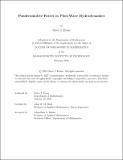Ponderomotive Forces in Pilot-Wave Hydrodynamics
Author(s)
Evans, Davis J.
DownloadThesis PDF (32.08Mb)
Advisor
Bush, John W. M.
Terms of use
Metadata
Show full item recordAbstract
Droplets bouncing on a vibrating bath may self-propel (or ‘walk’) via a resonant interaction with their self-induced pilot wave. In pilot-wave hydrodynamics (PWH), the spontaneous emergence of coherent, wave-like statistics from chaotic trajectories has been reported in several settings. Owing to the similarity of PWH to Louis de Broglie’s realist picture of quantum mechanics, the question of how such statistics emerge has received considerable recent attention.
A compelling setting where coherent statistics emerge in PWH is the hydrodynamic analog of the quantum corral. When walking droplets are confined to a circular cavity or ‘corral’, a coherent statistical pattern emerges, marked by peaks in the positional histogram coincident with extrema of the cavity eigenmode. Stroboscopic models that idealize the drop’s bouncing dynamics as being perfectly resonant with their Faraday wave field have proven incapable of capturing the emergent statistics.
In this thesis, we present new experimental and theoretical findings in a variety of pilotwave hydrodynamical settings where non-resonant bouncing plays a key role in the droplet dynamics and emergent statistics. First, we find that modulations to resonant bouncing influence the stability threshold of a Bravais lattice. Second, we demonstrate that resonant bouncing can be disrupted by the imposition of suboctave driving, which may be used to induce a rearrangement of bound states of bouncing droplets.
We then proceed to an integrated experimental and theoretical study of the hydrodynamic corral, highlighting the role of non-resonant bouncing in the emergent statistics. We first introduce a new experimental method for simultaneously measuring the drop position and pilot wave height. We then report new measurements of the pilot wave and vertical bouncing dynamics. We demonstrate that the complex pilot wave arising in corrals may play the same role as suboctave driving in disrupting resonant walking. Our experimental findings motivate a new theoretical framework that predicts that modulations in the histogram emerge as a consequence of ponderomotive effects induced by non-resonant bouncing. We then connect the ponderomotive drift observed in hydrodynamic corrals to extant theories of quantum mechanics.
Date issued
2025-02Department
Massachusetts Institute of Technology. Department of MathematicsPublisher
Massachusetts Institute of Technology